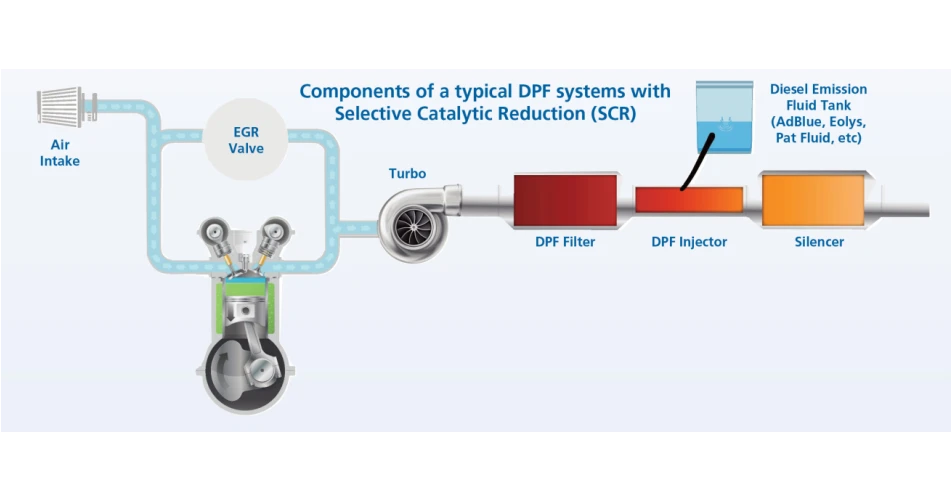DPF - Diesel Particulate Filter: A filter designed to trap exhaust emissions (soot) from diesel engines. It is generally a cordierite or silicon carbide wall flow filter. It is often coated with a catalytic material, to continuously burn the particulate collected in the filter. These filters can reduce the emission of dangerous particulate matter by around 90%. The soot is converted to ash during regeneration, some of which is expelled out the tailpipe. Some of the ash remains in the DPF, slowly filling it and reducing its ability to trap soot. When the DPF has accumulated a pre-determined amount of ash, it must be either cleaned or replaced.
After Treatment Devices: Systems for the removal of pollutants from exhaust gases once they have left the combustion chamber, such as Diesel Particulate Filters (DPF’s) and Catalytic Converters.
CO2 - Carbon Dioxide: A colourless, odourless, non-toxic gas that is one of the main bi-products of petrol and diesel combustion. Carbon dioxide is a greenhouse gas and as such, is a major contributor to global warming.
DEF - Diesel Exhaust Fluid: A fluid introduced into the exhaust system through a dosing valve between the diesel particulate filter and a selective catalytic reducer, designed to reduce emissions. It is a solution generally made up of two thirds de-ionised water and one third urea. Some examples are Eolys, PAT Fluid and AdBlue.
NOx - Nitrogen Oxides: A combination of air-polluting gases composed of nitrogen and oxygen which play an important role in the formation of smog and acidic rain.
Nanometre: 1 billionth of a metre. One million nanometres is only 1 millimetre in length.
DPF Regeneration: The process of burning off accumulated soot in a DPF. There are three types:
- Passive DPF Regeneration: This can only occur when conditions (accumulation of soot within the DPF, engine temperature, vehicle speed, etc.) as defined by the vehicle manufacturer have been met, and are maintained throughout the regeneration process. If any one of the requirements for Passive Regeneration are not met, and maintained through the regeneration process, the vehicle will look for the next opportunity to perform a Passive Regeneration. Due to driving habits of a significant number of Irish motorists, a Passive Regeneration may seldom, or maybe never, occur during the vehicles normal driving.
- Active DPF Regeneration: This occurs when the DPF exceeds a pre-set limit of soot accumulation. Extra fuel is injected to raise exhaust temperature and burn off the excess soot in the DPF. If this type of regeneration fails, due to low vehicle speeds or turning the engine off, the extra diesel will drain into the sump, contaminating your oil and causing the oil level to rise. An accumulation of this excess diesel fuel in the sump can cause physical damage by reducing lubrication, or can cause a runaway engine that sucks up the sump oil to continue running, even after the ignition is switched off
- Forced DPF Regeneration: This is a process whereby a mechanic using diagnostic equipment, forces the vehicle to perform regeneration with no regard to conditional requirements.
DPF Cleaning: When a DPF has become completely, or almost completely, blocked with soot or ash, it must be cleaned. Cleaning can be carried out with the DPF installed on the vehicle by using DPF cleaning chemicals. The DPF can also be removed for cleaning. Off car cleaning can use chemicals, ultrasonic sound waves or a combination of both methods to restore a DPF to as new condition. A DPF should never be pressure washed, as this may damage the catalyst on the surface of the filter.
EGR – Exhaust Gas Recirculation: A system that re-circulates small amounts of exhaust gas back into the charged inlet air.
GPF - Gasoline Particulate Filter: Emission after treatment devices for direct injection petrol engines, which perform a similar function to the DPF. These devises already appear on certain Mercedes and VW models.
Limp Mode: A process whereby a vehicle’s on board diagnostics will detect a problem with the exhaust system and go into a protection mode, where it will shut many of the vehicle systems down to protect the engine. This results in drastically reduced performance, such as engine power and vehicle speed, forcing the driver to seek professional assistance.
PM - Particulate Matter: Carbon-based particles formed by the incomplete combustion of fossil fuels, including Diesel and Petrol. The particles are extremely harmful and made up of elemental carbon, heavy hydrocarbons (SOF), and hydrated sulphuric acid or sulphate particulates. Significantly large volumes of extremely small PMs are produced during DPF Regeneration. These PMs range in size from 5-10 nanometres (5-10nm). These smaller PMs are more damaging to lungs, as they penetrate deeper into your lungs.
SCR – Selective Catalytic Reduction: A process that reduces dangerous NOx in diesel exhaust emissions using the injection of nitrogen-based reductants, such as ammonia or urea.
